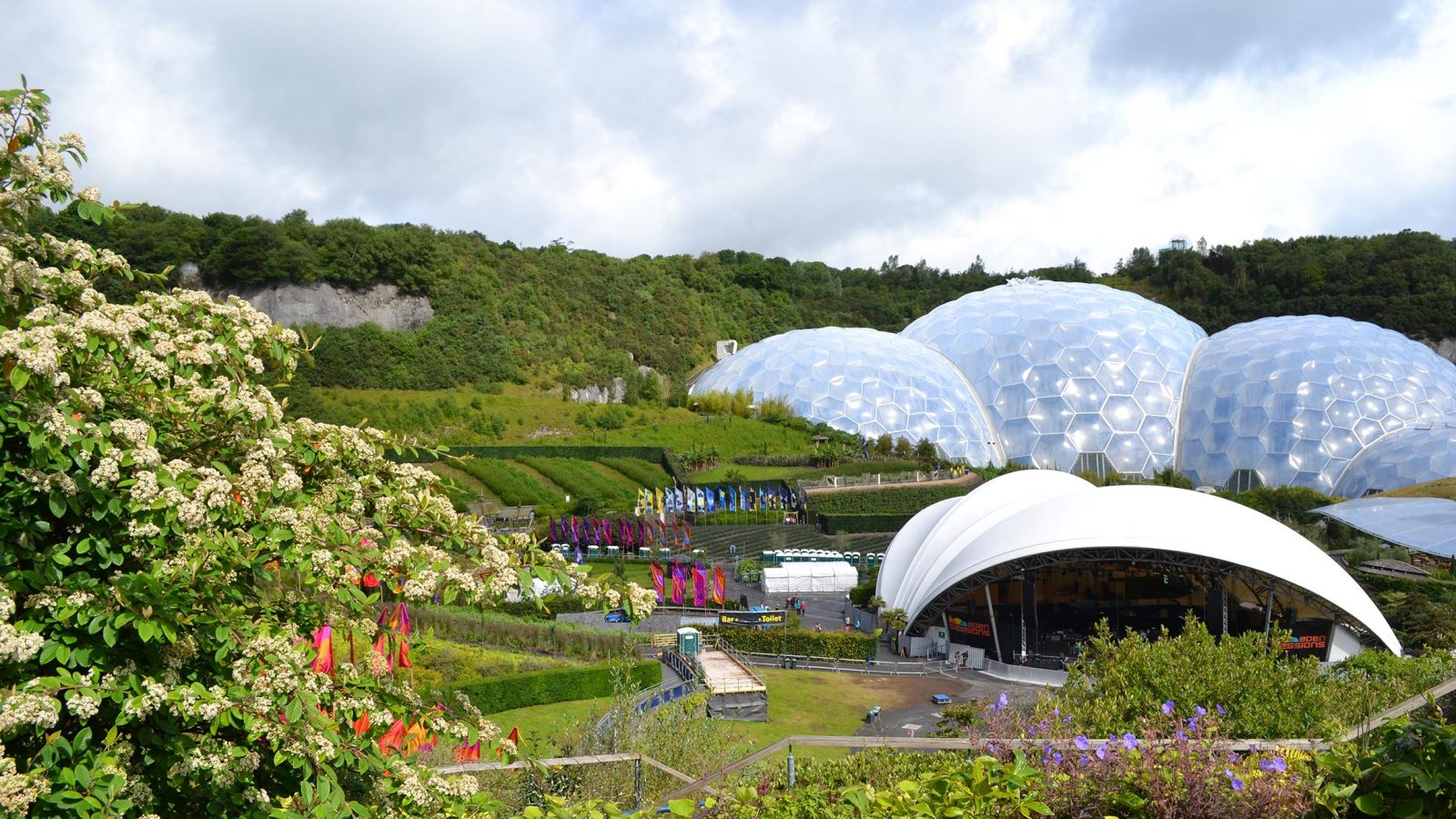Here are some answers to frequently asked questions.
There’s lots of information about geothermal energy, Eden Geothermal Ltd and the Eden Geothermal Project in the other sections of our website, too.
Eden Geothermal
Where is the Eden Geothermal site?
The geothermal site is just inside the main (north) entrance to the Eden Project. You’ll find access information in the Contact section of the website.
What was the Eden Geothermal site used for before?
It was a field on a former landfill site, that included an area of wet woodland. We constructed the operational area on the former landfill area (grass, brambles and scrub), leaving the woodland undisturbed.
Where was the Eden drilling rig from?
The drilling rig and crew werefrom the Czech Republic, and were supplied by a company called MND. MND have expertise in geothermal drilling gained from projects in Europe, and their Bentec 450 Eurorig, which is bigger than any UK-based land rig, had the 450-tonne hook load capacity necessary to drill such a deep well.
Why was drilling 24/7?
Once drilling starts, it’s a continuous operation that to be carried out 24/7. It can’t be stopped overnight or at weekends, for technical reasons. During drilling, large mud pumps are used to circulate the drilling muds, which carry cuttings (the rock that has been bored out) out of the hole. Stopping operations for anything but a very short period of time means that the cuttings will start to settle at the bottom of the hole around the BHA (the bottom hole assembly – i.e. the components at the bottom of the drill string) and the drill bit. If this happens, it becomes impossible to restart drilling or indeed to retrieve the BHA, and that section of the hole is lost. The only way to avoid this happening would be to ‘trip’ the drill string and everything attached to it out of the well (in other words, pull it all out). But as the well gets deeper, the time taken to trip out of and run back into the well increases, and soon exceeds 12 hours. By the time the rig has drilled to over 4,000 m, tripping out and running back in would require around 24 hours turnaround!
How many jobs were created by the project?
EGL had 12 full-time staff on this project, eight of them engineers. It also employed around 60 drillers and 75 drilling services personnel from 24 companies, mainly within the oil and gas and associated sectors. Geothermal represents an opportunity for a skills transfer from the oil and gas industry into a new, green renewables sector. In Germany the geothermal industry has created more than 22,000 skilled jobs, and added €13.3 billion to the economy since 2000.
Will circulating water in the Eden well have an impact on the water supply?
Water will be needed to set up the system when drilling is complete, but the well is totally encased with steel to a depth of 4km. This means that the water will circulate in a closed loop and will have no impact on local aquifers or present any risk of flooding at the surface. Any water released from the well during maintenance or normal running will be contained in a lagoon and treated.
Can I visit the site?
Yes! There is a public viewing area located at the southern end of the site on the public footpath / bridleway / cycle path which runs from Eden Project’s north gate. It’s accessible on foot at all times via the footpath, and during Eden Project opening hours, you can park at Cherry car park, which is the first car park on the right on entering the site via the north gate. There are information boards at the viewing area, and there’s no charge to visit. You can email info@edengeothermal.com if you’d like to arrange for someone to talk to you or your group.
How did the project cost?
To drill the first well, £20 million was secured from a combination of grant funding sources (the European Union through the European Regional Development Fund and Cornwall Council) and commercial funding from GCP Infrastructure Investments Limited, an investment trust advised by Gravis Capital Management Ltd.
Geothermal energy
Does using geothermal energy cool the Earth?
No. The Earth’s crust contains a virtually limitless quantity of heat which is continually replenished by heat conduction from the mantle and core beneath it. Geothermal energy extracts a minute fraction of this. Operating a geothermal system can cause temporary localised cooling around the well after a prolonged period of time, but the design life of the Eden plant is about 40 years, and after it has closed, the heat in the rock will recover, possibly allowing the well to be reused after some decades.
Is geothermal electricity more expensive than other energy sources?
Geothermal costs are largely upfront: drilling is expensive, and not every well will work. But once developed, geothermal plants are cheap to run. In countries with an established industry, conventional geothermal plants are cost competitive already. BEIS’ figures show that on a levelised cost basis, geothermal electricity from the lower temperature resources we have in the UK would be about the same price as onshore wind electricity, and cheaper than biomass. If the heat can be used directly, it is cheaper still, and the technology is still at a phase where substantial cost improvements are expected.
What about radiation?
Radon and background radiation are naturally present in the granites and clays of Cornwall, so as a precaution, we’ve engaged an independent Radiation Protection Advisor and we rigorously monitor operations. The chemical composition of the water and all waste streams are constantly checked throughout drilling, and when the system is operational, all water will circulate in a closed circuit so there will be no risk to the water table.
I’ve heard Engineered Geothermal Systems are the same as fracking!
Creating a geothermal heat exchanger is not the same as fracking, where rock is fractured under pressure to enable shale gas to be extracted.
- Our aim is not to extract fossil fuels for burning, but to capture natural heat and use it as renewable energy, so that we can move away from fossil fuel use.
- Unlike fracking, geothermal development doesn’t require the creation of new fractures in the rock. At Eden, we are drilling to target a known fault in the granite – the Great Crosscourse – which has natural fractures (cracks) and is therefore more permeable than the surrounding granite. Pumping water into the cracks in this target fault will enable the water to be superheated by the hot rock, and the water can then be brought to surface to supply heat or to generate electricity. By targeting a naturally fractured zone in the granite, we don’t need to inject proppant or the other chemicals that are used in shale gas exploration.
- As this is a renewable energy project and does not involve fracking, it is not covered under the same regulatory framework as shale gas exploration projects. Instead, it is regulated by the Local Authority and is monitored and managed using the protocols which have controlled and monitored mining and quarrying activity in the county for many years.
Can geothermal development cause earthquakes?
Small natural earthquakes (natural seismicity) regularly happen in the UK. 30 natural seismic events, with magnitudes between 0.3 and 2.9, were recorded during the 50-day period from April 22nd and June 10th 2021 (BGS). Most natural events are too small to ever be noticed at the surface; during this period only one of these natural earthquakes was ‘felt’. Earthquakes can also be caused by human activity (induced seismicity) such as mining, drilling, quarrying and blasting. Again, most of these events are too small to be felt at the surface.
In 2021, our first deep geothermal well was successfully drilled at the Eden Project in Cornwall, with no felt seismicity. During several months of well testing, there were hundreds of tiny ‘microseismic events’ but only 1 of these was noticed at surface, and there was no damage. Well-testing takes place after the well has been drilled, and is where the hydrogeological conditions in the well target zone are investigated, to give information about the viability of the geothermal resource. It typically involves short-term “injection and production tests”, where water is injected into the existing fracture network to fully permeate all the cracks of the fault.
Injection and production tests can induce extremely small levels of seismicity – known as microseismicity. Most of these induced events are below Magnitude 0 – much smaller than many natural seismic events which regularly occur in the UK – and are far too small to be felt at surface.
At Eden Geothermal, an independent company manages a network of sophisticated microseismic monitors in the vicinity of the well site, comprising sensitive surface seismometers and ground motion sensors and providing real-time data. This network enabled us to continuously measure microseismicity during drilling and testing, and the measurements recorded provided useful information about the spatial extent of the geothermal heat source. The microseismic network also enabled us to control injection and production conditions during well testing, to minimise the impact of any seismicity.
The operations at Eden Geothermal have provided a lot of useful information that helps us to better understand the stress regime and seismic response that occurs at great depth beneath Cornwall, and which will help us to mitigate any risk with future developments.
There’s more information about seismicity, including a short film and a downloadable information sheet, on our welltesting webpage here









